The success of Foursquare’s Pilgrim SDK shows that there are many more ways that you can construct meaningful bridges between digital spaces and physical places. Consider how the shopping and dining experience have become more convenient due to the convergence of online and offline, such as the ability to book a table from your smartphone.
Edward Tinsley, a director of business development at Foursquare, is a passionate believer in using Pilgrim SDK to help users construct meaningful bridges between digital spaces and physical places. We caught up with him to find out what kinds of apps he would build to do just that. First, he told us a little bit about his life as British expat living in New York City.
Tell us about yourself.
I’m from London, but I’m American by heritage. I’ve been here for five years and live in Brooklyn, by Prospect Park. The openness and diversity of New York is particularly cool, and the can-do positive work environment is really inspiring.
I’ve been at Foursquare for nearly three years, and am still excited to come to work every day and discuss interesting, new app and feature ideas with my clients.
What would you build with our superpower, Pilgrim SDK?
A better dating app! For example, I’d use the SDK to match people when they’re at the same location—like a music festival— in real time. Because shared experiences at concerts or festivals reveal so much about our interests, Pilgrim SDK could enable developers to distill location data into meaningful insights.
The trick would be to build a user experience that ensures both people are open to having a conversation while also protecting each user’s privacy.
What’s your favorite Pilgrim SDK feature and why?
We’ve recently rolled out a new feature called User States. The commuting state, in particular, helps app developers and brands figure out when someone is traveling to and from work so they can give users helpful tips and content along the way.
Let’s think of another example. Imagine you’re developing a news app that summarizes the day’s events while you’re on your evening commute. It could proactively let you know which gas station has the lowest price by sending a targeted notification. By making location data like this actionable, developers will have an easier time building context-aware features and apps.
What tips do you have for independent developers about Pilgrim SDK?
I recommend that you be creative. Think very broadly about use cases; don’t just be constrained by Foursquare’s own use cases, or what’s already out there. You truly have nothing to lose.
Build contextual app experiences with location using Pilgrim SDK. Create a free account and start building today. And for some feature or app thought-starters, check out our ongoing Q&A series about development ideas.
Have you built something cool with Pilgrim SDK? Submit it to this form and you may be featured on Intersections.



